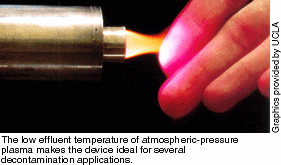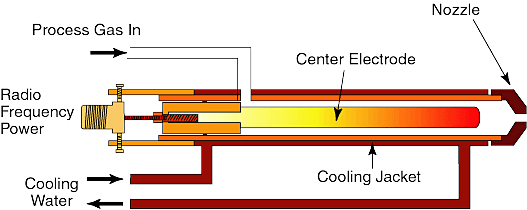
Research yields new tool for surface decontaminationThrough the Environmental
Management Science Program (EMSP), DOE’s
Office of Environmental
Management (EM) and Office
of Science (SC) collaborate to fund basic research to solve intractable
problems that threaten the successful closure of DOE sites. As one of
the programs within the Office of Science
and Technology, EMSP ensures that OST’s projects cover the
full spectrum of R&D. EMSP’s Web site is at http://emsp.em.doe.gov.
The device selectively removes heavy metals from surfaces, making objects
and structures radiation free. Volatile reaction products are captured
on filters, enabling buildings and equipment to be safely decommissioned
while dramatically reducing the volume of waste to be treated as contaminated.
In addition, because the process doesn’t overheat the surface or
require the addition of large quantities of chemicals, it doesn’t
threaten the health and safety of D&D personnel. The plasma jet consists of two concentric electrodes separated by 1–3
mm. The inner electrode is driven with 50–500 watts of radio frequency
power; the outer electrode is grounded. Feed gas containing helium and
other gases is ionized as it flows between the electrodes. The electrons
in this plasma are not in equilibrium with the rest of the gas: their
energy is 2–3 electron volts, or more than 20,000°C. As the plasma
emerges from the nozzle and hits a substrate 2–10 mm downstream, the
material is “etched” (cleaned).
With the addition of fluorine-containing compounds to the feed gas,
the atmospheric-pressure plasma can strip a wide range of radioactive
elements from contaminated structures and equipment. Tests on tantalum,
a surrogate for plutonium, have demonstrated satisfactory etch rates
under relatively mild conditions. For example, with a feed of 97.5%
helium, 2% carbon tetrafluoride, and 0.5% oxygen, the plasma jet etches
tantalum foil placed 5 mm downstream at 6 micrometers per minute. In
this case, the plasma is driven with 400 W, and the metal sample is
heated to 250°C. Alternative methods either have much higher power
requirements or must operate in a vacuum chamber. During its first three-year project, the research team made numerous
improvements in the design of the plasma jet, which can operate for
hundreds of hours without degradation in performance. Several source
designs are scalable to large areas and can treat a variety of objects,
including gloveboxes and building walls. Compact units have also been
developed to facilitate field deployment. The research team, which won
an R&D 100 Award in 1999, has obtained one U.S. patent and filed
additional applications. Several companies have expressed an interest
in acquiring patent rights and commercializing the plasma jet technology. EMSP recently extended the research program to fully characterize the discharge physics and chemistry, engineer the exhaust containment system, and perform field tests. Tests on actinide contamination are planned at LANL’s plutonium facility. And if research exploring the removal of zirconium and strontium is successful, the plasma device will be tested at Idaho National Engineering and Environmental Laboratory to remove contamination with those materials.
In the first-generation atmospheric-pressure plasma device, process gas is ionized between two coaxial electrodes. The nozzle directs the reactive gas onto the target surface. For more information on this research, contact principal investigator
Robert Hicks, University of California at Los Angeles, (310) 206-6865,
hicks@ea.ucla.edu. |
 The
decontamination and decommissioning of buildings, structures, and materials
is one of the most expensive and challenging components of the DOE cleanup
effort. Baseline methods using wet chemical solvents and mechanical
blasting generate substantial secondary waste and expose workers to
risk. With funding from EMSP, researchers at the
The
decontamination and decommissioning of buildings, structures, and materials
is one of the most expensive and challenging components of the DOE cleanup
effort. Baseline methods using wet chemical solvents and mechanical
blasting generate substantial secondary waste and expose workers to
risk. With funding from EMSP, researchers at the 